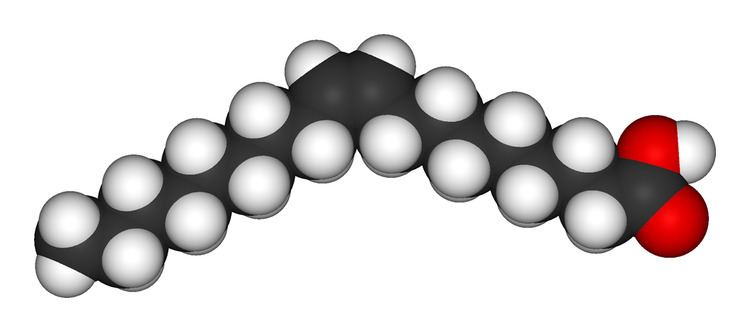 | ||
In biochemistry and nutrition, monounsaturated fatty acids (abbreviated MUFAs, or more plainly monounsaturated fats) are fatty acids that have one double bond in the fatty acid chain with all of the remainder carbon atoms being single-bonded. By contrast, polyunsaturated fatty acids (PUFAs) have more than one double bond.
Contents
Fatty acids are long-chained molecules having an alkyl group at one end and a carboxylic acid group at the other end. Fatty acid viscosity (thickness) and melting temperature increases with decreasing number of double bonds; therefore, monounsaturated fatty acids have a higher melting point than polyunsaturated fatty acids (more double bonds) and a lower melting point than saturated fatty acids (no double bonds). Monounsaturated fatty acids are liquids at room temperature and semisolid or solid when refrigerated.
Molecular description of monounsaturated fatty acids
Common monounsaturated fatty acids are palmitoleic acid (16:1 n−7), cis-vaccenic acid (18:1 n−7) and oleic acid (18:1 n−9). Palmitoleic acid has 16 carbon atoms with the first double bond occurring 7 carbon atoms away from the methyl group (and 9 carbons from the carboxyl end). It can be lengthened to the 18-carbon cis-vaccenic acid. Oleic acid has 18 carbon atoms with the first double bond occurring 9 carbon atoms away from the carboxylic acid group. The illustrations below show a molecule of oleic acid in Lewis formula and as a space-filling model.
Relation to health
Polyunsaturated fats protect against cardiovascular disease by providing more membrane fluidity than monounsaturated fats, but they are more vulnerable to lipid peroxidation (rancidity). The large scale KANWU study found that increasing monounsaturated fat and decreasing saturated fat intake could improve insulin sensitivity, but only when the overall fat intake of the diet was low. However, some monounsaturated fatty acids (in the same way as saturated fats) may promote insulin resistance, whereas polyunsaturated fatty acids may be protective against insulin resistance. Studies have shown that substituting dietary monounsaturated fat for saturated fat is associated with increased daily physical activity and resting energy expenditure. More physical activity was associated with a higher-oleic acid diet than one of a palmitic acid diet. From the study, it is shown that more monounsaturated fats lead to less anger and irritability.
Foods containing monounsaturated fats reduce low-density lipoprotein (LDL) cholesterol, while possibly increasing high-density lipoprotein (HDL) cholesterol. However, their true ability to raise HDL is still in debate.
Levels of oleic along with other monounsaturated fatty acids in red blood cell membranes were positively associated with breast cancer risk. The saturation index (SI) of the same membranes was inversely associated with breast cancer risk. Monounsaturated fats and low SI in erythrocyte membranes are predictors of postmenopausal breast cancer. Both of these variables depend on the activity of the enzyme delta-9 desaturase (Δ9-d).
In children, consumption of monounsaturated oils is associated with healthier serum lipid profiles.
The Mediterranean Diet is one heavily influenced by monounsaturated fats. People in Mediterranean countries consume more total fat than Northern European countries, but most of the fat is in the form of monounsaturated fatty acids from olive oil and omega-3 fatty acids from fish, vegetables, and certain meats like lamb, while consumption of saturated fat is minimal in comparison. The diet in Crete is fairly high in total fat (40% of total calories, almost exclusively provided by olive oil) yet affords a remarkable protection from coronary heart disease (and probably colon cancer) , but unlikely from breast cancer due to a very high oleic acid content.
